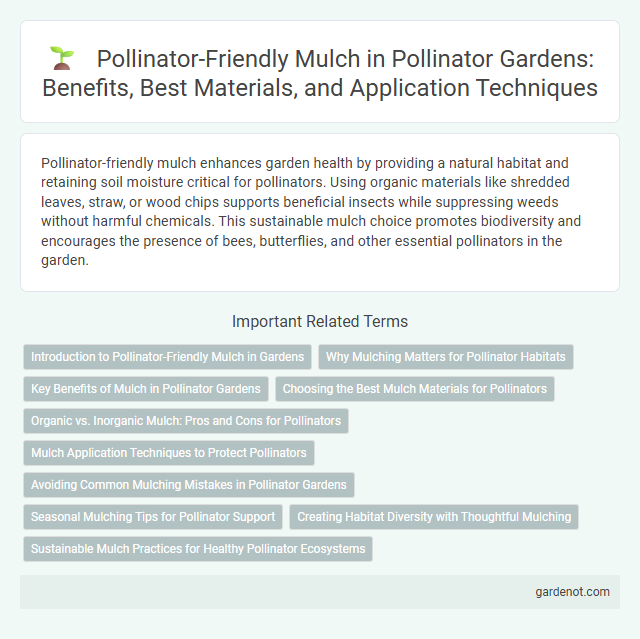Pollinator-friendly mulch enhances garden health by providing a natural habitat and retaining soil moisture critical for pollinators. Using organic materials like shredded leaves, straw, or wood chips supports beneficial insects while suppressing weeds without harmful chemicals. This sustainable mulch choice promotes biodiversity and encourages the presence of bees, butterflies, and other essential pollinators in the garden.
Introduction to Pollinator-Friendly Mulch in Gardens
Pollinator-friendly mulch plays a crucial role in creating a supportive environment for bees, butterflies, and other beneficial insects in gardens. This type of mulch consists of natural materials like shredded leaves, straw, and untreated wood chips that avoid harmful chemicals and provide essential habitat features such as moisture retention and nesting sites. Utilizing pollinator-friendly mulch enhances biodiversity while promoting healthy soil conditions critical for flowering plants and pollinator activity.
Why Mulching Matters for Pollinator Habitats
Mulching with organic materials like shredded leaves or bark enhances soil moisture retention and regulates temperature, creating an ideal environment for pollinator nesting and foraging. Pollinator-friendly mulch reduces weed competition without harmful chemicals, supporting native plant health and diversity essential for pollinator nutrition. Proper mulching also minimizes soil erosion, preserving habitat integrity for bees, butterflies, and other vital pollinators.
Key Benefits of Mulch in Pollinator Gardens
Pollinator-friendly mulch enhances soil moisture retention and temperature regulation, creating an optimal habitat for beneficial insects like bees and butterflies. It suppresses weed growth without harmful chemicals, reducing competition for nectar plants essential to pollinators. Mulch also breaks down into organic matter, enriching soil fertility and supporting healthy plant growth crucial for sustained pollinator activity.
Choosing the Best Mulch Materials for Pollinators
Choosing pollinator-friendly mulch involves prioritizing organic materials such as shredded bark, pine needles, and composted leaves that improve soil health and provide habitat for beneficial insects. Avoiding synthetic mulches and heavily processed wood chips reduces chemical exposure and enhances moisture retention, creating an ideal environment for bees, butterflies, and other pollinators. Incorporating diverse mulch layers also supports native flora growth, boosting nectar and pollen availability essential for pollinator populations.
Organic vs. Inorganic Mulch: Pros and Cons for Pollinators
Organic mulch, such as wood chips, straw, and compost, enhances soil health by retaining moisture and providing habitat for beneficial insects, supporting pollinator populations. Inorganic mulch, including rubber and plastic, offers durability and weed control but may hinder soil aeration and reduce floral diversity, negatively impacting pollinators. Choosing organic mulch fosters a more pollinator-friendly garden ecosystem by promoting nutrient cycling and shelter for native pollinators.
Mulch Application Techniques to Protect Pollinators
Applying mulch in pollinator gardens requires careful techniques to avoid disrupting nesting bees and other beneficial insects. Use thin, uneven layers of organic mulch such as shredded leaves or bark to maintain soil moisture while allowing pollinators to access the ground. Avoid deep or compacted mulch that can trap insects or obscure flowering plants essential for foraging.
Avoiding Common Mulching Mistakes in Pollinator Gardens
Choosing pollinator-friendly mulch such as shredded leaves or straw helps retain soil moisture and supports beneficial insect habitats while avoiding cedar or black walnut chips that can harm pollinators. Applying mulch too thickly can suffocate emerging plants and reduce airflow, hindering pollinator activity. Keep mulch layers between 1 to 2 inches to protect delicate pollinator roots and maintain a healthy garden ecosystem.
Seasonal Mulching Tips for Pollinator Support
Applying pollinator-friendly mulch such as shredded leaves, straw, or bark in early spring helps retain soil moisture and suppress weeds, creating a healthy habitat for bees and butterflies. Avoid using dyed or synthetic mulches that may contain harmful chemicals detrimental to pollinator health. Replenish mulch layers in late fall to provide insulation and nesting materials, supporting overwintering pollinators effectively.
Creating Habitat Diversity with Thoughtful Mulching
Pollinator-friendly mulch enhances habitat diversity by supporting beneficial insects such as bees, butterflies, and beetles that rely on varied soil and plant conditions. Materials like shredded bark, leaf litter, and straw provide shelter, nesting sites, and moisture retention without disrupting pollinator activity. Thoughtful mulching promotes a thriving ecosystem by balancing soil health, plant growth, and pollinator resource availability.
Sustainable Mulch Practices for Healthy Pollinator Ecosystems
Sustainable mulch practices in pollinator gardens enhance soil moisture retention and suppress weeds without harming beneficial insects. Organic mulches such as shredded leaves, straw, and wood chips provide essential habitat and forage opportunities for native bees and butterflies. Avoiding synthetic mulches and ensuring mulch layers are not too thick helps maintain soil aeration and supports a thriving pollinator ecosystem.
Pollinator-friendly mulch Infographic

 gardenot.com
gardenot.com